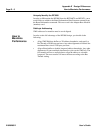
User’s Guide 21020285 D
Appendix E Design Differences
Implementation Differences Page E - 5
Unit Options and Extended Unit Options Commands - The Unit SCSI
ID byte in both commands can now contain a number from 0 to 0FH.
Board Statistics Command - The Statistics Data Structure returned from
a Board Statistics command now reports statistics for units at SCSI ID’s 8
through 15 starting at Offset 28H. This is shown in Table 68 on page 7 - 12.
These bytes were reserved on the RF3560/70 and RF3870. The RF3510 used
these bytes for Floppy Statistics.
Extended Board Statistics Command - The Extended Board Statistics
Command Parameter Block has a new field, shown in Table 100 on page 7 -
41. Called the Options field, its purpose is to allow you choose whether statistics
for all possible SCSI ID’s is returned in the Extended Board Statistics Data
Structure (length D4H bytes) or is limited to eight (length 74H bytes).
Bus Throttle
The RF3880 uses a new scheme to control the number of VME transfers to
make each burst. The Bus Throttle byte specifies the number of bytes in a burst
as a power of 2. Valid values are 0 to 0BH. Any values larger than 0BH will
be changed to 0BH.
The value of the Bus Throttle byte is set in the General Options Command and
is reported in the Board Information Command Data Structure.
It is valuable to note that VME D64 Block Modes limit the size of a burst on
the bus to 2048 bytes per burst. To take advantage of this, the data transfer
addresses you use must be aligned on 2048 byte boundaries. Any other
alignment and the burst size will be limited to 256 bytes per burst.
Non VME D64 Block Modes limit the burst size on the bus to 256 bytes per
burst.
Non Block Modes allow burst sizes to 2048 bytes per burst.
Block Mode Transfers
The RF3880 assigns a new meaning to the BMT bit that is part of the Select
Flags field of the General Options Command.
SCSI Data Widths
The RF3880 supports SCSI data widths of 8 or 16 bits. Negotiation for 16 bit
wide SCSI is enabled by setting Bit 3 (WID) of the Unit Options Command’s
Unit Flags field, shown in Table 76 on page 7 - 20 or by setting the same bit in
the Unit Flags field of the Extended Unit Options command, shown in Table
106 on page 7 - 48.
Additionally, the Board Information Command reports the current setting of
the bit in it’s Device Flags Field and the Per Target-Width field reports the
result of the negotiation.


















